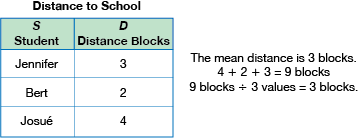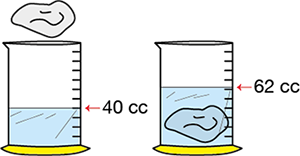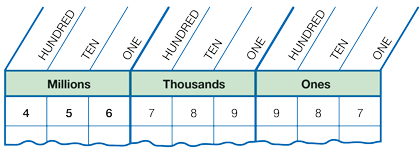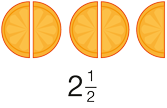M
manipulated variable
In an experiment, the variable with values known at the beginning of the experiment. The experimenter often chooses these values before data collection. It is often called the independent variable.
pages 351–353
mass
The amount of matter in an object.
pages 329, 333, 394, 532, 537–542, 543–550
mean
An average of a set of data values that is found by adding the values and dividing by the number of values.

pages 10, 21, 339–348, 554
measurement division
Division as equal grouping. The total number of objects and the number of objects in each group are known. The number of groups is the unknown. For example, tulip bulbs come in packages of 8. If 216 bulbs are sold, how many packages are sold?
measurement error
The unavoidable error that occurs due to the limitations inherent to any measurement instrument.
measuring (volume) by displacement
A way of measuring volume by measuring the amount of water (or some other fluid) it displaces.

pages 537–542, 543–550
median
An average of a set of data values that is found by identifying the middle value. For a set with an odd number of data arranged in order, it is the middle number. For an even number of data arranged in order, it is the number halfway between the two middle numbers.

pages 10–16, 20–22, 33, 37–41, 48–50, 337–338, 339–348
meniscus
The curved surface formed when a liquid creeps up the side of a container (for example, a graduated cylinder).

mental math
Mental math refers to any strategy that does not rely on a fixed computational algorithm, but involves the flexible use of operations to simplify problems (e.g., modeling a problem with coins or thinking of 99 × 4 as 100 × 4 − 4). While mental math strategies lend themselves to efficient mental computations, they may still involve intermediate calculations on paper or use of manipulatives, as students learn how to use the strategies.

pages 139, 166, 170–171, 172, 301, 304–305, 471–473, 474–478
meter
A unit of length in the metric system. A meter is 100 centimeters or a little more than 39 inches.
pages 361, 412, 415, 510, 539, 559
milliliter
A measure of capacity in the metric system that is the volume of a cube that is one centimeter long on each side.
page 332
millimeter
A unit of length in the metric system. A millimeter is 
pages 360–361
million
The sequence of digits in the millions place, the ten millions place, and the hundred millions place. In the number 456,789,987, the millions period is in the bold type.

pages 121, 124, 126–128, 131, 134, 147, 157, 391–392
millionths
1 of 1,000,000 equal parts of a whole (.000001).
pages 391–392
mixed number
Numbers made up of a whole number and a fraction, e.g., 2

pages 61, 70–73, 80, 96, 466–469, 470–473, 474–478
mode
An average of a set of data values that is found by identifying the value that appears most frequently. Sometimes that number is used to represent the whole data set.
pages 6, 9, 10–16, 19–21, 48, 50
Mr. Origin
A plastic figure used to represent the origin of a coordinate system and to indicate the directions of the x- and y- axes (and possibly the z-axis).
pages 271–272
multiple
The products of a number and another number. For example, 15, 25, and 40 are multiples of 5. A number is a multiple of another number if it is evenly divisible by that number. For example, 12 is a multiple of 2 since 2 divides 12 evenly.
pages 35, 38, 41, 141, 429–431, 449, 450–453
multiples of ten
The products of ten and another number. For example, 20, 30, 40, and 100 are multiples of ten.
pages 131, 141, 154, 294










